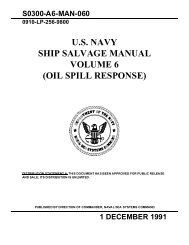Gallon JP-5 Spill at Naval Station Roosevelt Roads - Supervisor of ...
Gallon JP-5 Spill at Naval Station Roosevelt Roads - Supervisor of ...
Gallon JP-5 Spill at Naval Station Roosevelt Roads - Supervisor of ...
You also want an ePaper? Increase the reach of your titles
YUMPU automatically turns print PDFs into web optimized ePapers that Google loves.
Winter 1999/2000SUPSALV Teams with NOAATo Quantify Oil <strong>Spill</strong> RiskAnalyses <strong>at</strong> Navy PortsNOAA’s Hazardous M<strong>at</strong>erials ResponseDivision has developed an advanced toolto quantify and characterize the risksposed by oil spills on w<strong>at</strong>er. This tool,called the Trajectory Analysis Planner, orTAP, goes well beyond analyzing risksand developing associ<strong>at</strong>ed responseplans based entirely on a single “worstcase spill” event as determined strictlyby largest volume. R<strong>at</strong>her, the TAP programdeveloped by NOAA HAZMAT isintended to fully evalu<strong>at</strong>e oil spill risks ina given area or body <strong>of</strong> w<strong>at</strong>er based onthe entire range <strong>of</strong> potential spill volumesand loc<strong>at</strong>ions.Background Leading up to the Navy’sUse <strong>of</strong> TAP. The US Navy has carefullyevalu<strong>at</strong>ed its oil spill risks over the yearsto establish the need for procuring andpre-staging spill response equipment <strong>at</strong>the local (Tier 1), regional (Tier 2), andn<strong>at</strong>ional (Tier 3) levels. In the past, theNavy has evalu<strong>at</strong>ed oil spill risks basedprimarily on oil throughput and ship transits,port calls, and fueling evolutions.This “first order” risk analysis essentiallyestablished the Navy homeports and bulkfuel storage facilities as the Navy’s highspill risk areas. With the passage <strong>of</strong> theOil Pollution Act <strong>of</strong> 1990 (OPA 90), theNavy took a hard look <strong>at</strong> its worst casedischarge (WCD) scenarios, defined byOPA 90 as the largest spill volume withina specific Captain <strong>of</strong> the Port zone. Navyfacility plans were upd<strong>at</strong>ed and revisedto comply with the many provisions <strong>of</strong>the OPA 90 implementing regul<strong>at</strong>ions,and Navy regional response plans, calledNavy On-Scene Coordin<strong>at</strong>or (NOSC)plans, were also revised to address specificWCD events.In the nine years since OPA 90, variouscoastal st<strong>at</strong>es have promulg<strong>at</strong>ed regul<strong>at</strong>ionsth<strong>at</strong> require oil tankers and certainother vessels to conduct risk analysesth<strong>at</strong> go far beyond addressing the largestpossible volume spill event. Like thest<strong>at</strong>e regul<strong>at</strong>ors, the Navy, other potentialspillers, and federal and local plannersrecognized the value <strong>of</strong> performingmore comprehensive analyses <strong>of</strong> any andall spills th<strong>at</strong> could occur within a givenarea. This move toward st<strong>at</strong>istics-basedrisk assessments th<strong>at</strong> examined multiplespill scenarios <strong>at</strong> multiple loc<strong>at</strong>ions interestedthe Navy. Furthermore, the Navyhad experienced many changes in its facilitiesdue to newly established shiphomeports and consolid<strong>at</strong>ions resultingfrom base closures. In summary, the timingwas right for the Navy to begin reexaminingits oil spill risks.The Navy/NOAA Partnership.SUPSALV evalu<strong>at</strong>ed numerous <strong>of</strong>f-theshelfoil spill risk analyses tools and programs.Ultim<strong>at</strong>ely, NOAA’s TAP applic<strong>at</strong>ionwas accepted for the followingreasons: SUPSALV was already familiarwith most <strong>of</strong> the NOAA spill readinessand response applic<strong>at</strong>ions and had alreadyestablished internet links with theseapplic<strong>at</strong>ions to assist the NOSCs withtheir area-wide planning responsibilities;TAP provided the potential to examinecurrent Navy response equipment capabilitiesagainst Navy oil spill risks; andmuch <strong>of</strong> the hydrodynamic d<strong>at</strong>a requiredto build local TAP trajectory models andconduct the TAP analyses already residedwithin NOAA or the Navy---thus the largeinitial expenditures for obtaining the rawor digitized d<strong>at</strong>a typically associ<strong>at</strong>ed withstart-up for risk analyses were not necessary.In March <strong>of</strong> 1999, SUPSALV andNOAA began a pilot study <strong>of</strong> TAP forSan Diego Harbor. Because TAP investig<strong>at</strong>esthe probabilities th<strong>at</strong> spilled oil willmove and spread in particular ways withina particular area, the first step establishedthe set <strong>of</strong> hydrologic, oceanographic, andmeteorological conditions th<strong>at</strong> were specificto San Diego Harbor. Using this d<strong>at</strong>a,tide and wind currents were then modeledfor both the Bay and the approachesjust outside the Bay. The shoreline forthe study area was divided into 190 separ<strong>at</strong>esegments <strong>of</strong> 0.5 km in length. Theseloc<strong>at</strong>ions represented the receptor sites.Then, 183 spill loc<strong>at</strong>ions were chosen, and500 independent spill trajectory runs weredone for each <strong>of</strong> these loc<strong>at</strong>ions for eachseason. These spill trajectories were runfor five days in 0.1 hour increments.The TAP analyses for San Diego Bayallows the user to choose four differentmodes to view the compiled d<strong>at</strong>a.1. Thre<strong>at</strong> Zone Analysis: This is agraphical display showing contours <strong>of</strong>where various st<strong>at</strong>istical spills origin<strong>at</strong>ed.This mode can help answer thequestion <strong>of</strong> where oil could come fromif one wants to protect a specific site.2. Shoreline Impact Analysis: Thisdisplay identifies the percent <strong>of</strong> spillsth<strong>at</strong> impact the various receptor sites,and is particularly useful in identifyingwhether oil spilled <strong>at</strong> a given spotwill impact given shoreline loc<strong>at</strong>ions.3. Site Oiling Analysis: This displayprovides a way to visualize how a particularsite is likely to be oiled by aspill origin<strong>at</strong>ing <strong>at</strong> a particular loc<strong>at</strong>ion,allowing the planner to estim<strong>at</strong>ehow much oil the responders shouldbe prepared for <strong>at</strong> a particular site.4. Shoreline Resource Analysis:This display represents the cumul<strong>at</strong>ivecost or consequence <strong>of</strong> oil impacts toall sites thre<strong>at</strong>ened by all modeledspills from a given loc<strong>at</strong>ion. The costor consequence <strong>of</strong> a site can be anythingidentified in an appropri<strong>at</strong>e unit,such as response equipment, restor<strong>at</strong>ioncosts, wildlife impacted, etc.Navy/NOAA Plans for TAP.SUPSALV is continuing its partnershipwith NOAA to enhance the output andapplic<strong>at</strong>ion <strong>of</strong> TAP. Over this next year,SUPSALV and NOAA intend to build onthe resource analysis capabilities <strong>of</strong> TAP,continuing to use San Diego Bay as apilot study area. By the completion <strong>of</strong>FY 2000, SUPSALV hopes to have valid<strong>at</strong>edthe inventories and loc<strong>at</strong>ions <strong>of</strong>local Navy response equipment as wellas the major SUPSALV equipment inventoriespre-staged in Port Huenemeand San Diego. Should any equipmentshortfalls be identified, SUPSALV willdiscuss these deficiencies directly withtheir resource sponsor to program andpre-stage additional equipment.15
















